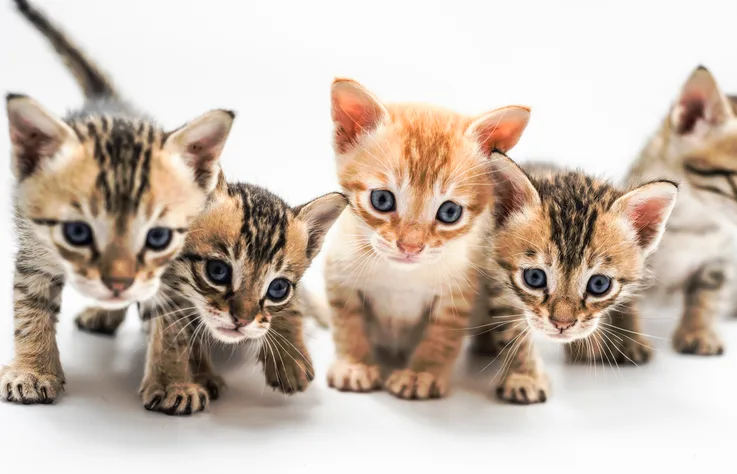Socializing Kittens
Debra F. Horwitz, DVM, DACVB, Veterinary Behavior Consultation

Because of the increasing popularity of cats, providing cat owners with good information about kitten behavior and development is important and can help prevent relinquishment.
Feline Development
A kitten’s development parallels that of a puppy, with distinct phases during which they develop in predictable ways. This development is influenced by many factors, including genetics and environment.<sup1 sup>
The earliest stages of development occur before adoption, but from 4 weeks of age onward, many kittens have interactions with people. Weaning generally begins at about 4 weeks and is completed by 7 weeks. Voluntary elimination develops between 5 and 6 weeks; kittens placed in a loose material will begin to dig, eliminate, and cover the voided matter. Social play begins with chasing, hiding, and pouncing. As eye–paw coordination develops, so does object play and predatory play sequences. Between 8 to 12 weeks, social play peaks and then begins to decline, and agonistic play becomes more prominent.
Although kittens do not usually go to homes before they are 6 to 7 weeks of age, early handling has been shown to affect behavioral and physical development in cats. Kittens handled on a daily basis at a very young age showed earlier eye opening, emergence from the nest, and increased willingness to approach strange humans and toys.
Nutrition during gestation also affects early development. Kittens born to malnourished mothers have behavioral and growth aberrations, including cognitive impairment, antisocial behavior to other cats, and abnormal levels of fear and aggression. These abnormalities may also be seen in kittens whose mothers were undernourished during lactation. Even when such kittens are nutritionally rehabilitated, problems may persist. Kittens separated from the mother at an early age (2 weeks) seem to be at risk for behavioral and emotional abnormalities, including increased reactivity, fearful and aggressive behaviors toward people and other cats, and cognitive impairment.2
Socialization
In the early 1980s, a series of experiments evaluated the effect of handling on the subsequent behavior of kittens toward humans.3 These experiments, which varied both the amount of handling and the age at which handling was started, helped determine when the sensitive period of socialization occurred: between 2 and 7 weeks of age. More recent studies done in homes as opposed to laboratories have confirmed this 2- to 7-week window as the sensitive period during which kittens socialize to humans as well as to other animals. After 7 weeks, attachments and preferences can be formed, but slowly and with more difficulty. Kitten-to-human socialization is facilitated by the presence of the queen if she is calm and social.4
Personality may also influence how a kitten responds to novel things. Several sources have defined two common personality types: (1) sociable, confident, and easygoing; (2) timid, shy, and unfriendly.5 Some other research has also indicated an active aggressive type as well.5
Selection
During selection of a kitten for family placement, investigating the animal’s early development may aid in more successful home integration. Early interaction with humans is important; early handling facilitates behavioral and emotional development and is essential during the socialization period. Questions about the food choice and substrate preference of the queen may also help prevent early non–litter box use and foster good nutritional intake, since these are also learned from the queen. Some research has suggested that personality in cats is heritable, with some influence coming from the father as well, so questions about both parents might be helpful.6
Home Integration
When a kitten is first brought home, transportation should be done in a cat carrier for safety and comfort. Once at home, the kitten should be provided a quiet, secure area as a home base. This area should include an appropriately sized litter box, food bowl, and water as well as a comfortable resting place. Care should be taken that any potentially harmful items are removed and that there are no small areas where the kitten could become trapped. When supervised, the kitten can be allowed to explore the new environment. Supervision helps prevent inadvertent destruction or scratching of household possessions. When the owners are away, the kitten can remain in its home area for safety. Appropriate toys should be provided, and playtime should be encouraged daily.
Training
Appropriate human–cat interactions should be fostered immediately. This can include rewards for coming when called; calm, quiet behavior; and responding to its name. Owners should be encouraged to reward litter box use and to keep the box clean and in a private area. A scratching/marking post should be provided and use encouraged. Handling exercises to minimize future battles over grooming, body handling, and medicating can be started using food rewards. Finally, the kitten should be introduced to new things in a calm, nonthreatening manner and rewarded for good behavior. Kitten kindergarten classes provide ongoing socialization, education about normal behavior, and training tips for kitten owners. Such classes are best attended by kittens younger than 13 weeks of age. Dr. Kersti Seksel from Australia first developed Kitten Kindy.7 These social settings provide pet owners a place to learn about their kittens and kittens can interact and play with other kittens and learn social skills. Because the window of optimum socialization is narrow, classes must be carefully controlled to avoid agonistic encounters. Owners of older kittens may attend alone to learn and ask questions.
What to Do
Make sure kittens have been handled early in life, between 3 and 7 weeks.
Get information about previous home, handling, litter use, and food preferences.
Set up a safe area with food, water, and an appropriately sized litter box.
Provide daily interaction and playtime as well as training and handling exercises.
Attend a kitten kindergarten class for additional tips on training and problem prevention.